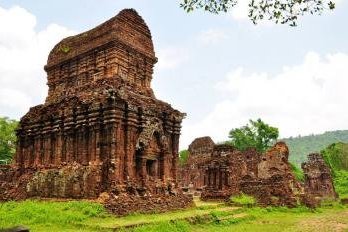
Hidden away in the tropical forest near the port city of Danang and the very popular World Heritage town of Hoi An is the Champa civilization’s sacred valley of My Son, pronounced like Mee Cern, or beautiful mountain (from Chinese word Mei Shan). I joined the full day package tour from Hoi An which was quite very convenient as it included all transportation, ticket fee, lunch and guide. I arrived in My Son around 10 o’clock. The recently built interpretation center funded by a big Korean company was the first thing I saw, but the guide dictated us to go in a different direction into the forest. After walking for a while I found the complex of tourist facilities, and one of them is the performance hall. The loud traditional music and cheerful sound of Chinese tourists really caught my attention, as I read many comments about sexy Cham dancers before I came here, but again our guide insisted us to keep going into the forest. Within few minutes I started to see the complex of ancient Hindu temple made from brick.
At first the dilapidated state of the complex was quite shocking, and almost nothing left to see. I decided to discover the site by myself after my guide started to explain how cruel of French and American during colonial rule and Vietnam War. I started to impress the amazing quality of brick craving details. The image of Hinduism guardians and angels are truly beautiful and reminded me Angkor in Cambodia. For me My Son is the great evidence of how Southern Indian art expanded to Southeast Asia since ancient Cham people came from Java where Indian art flourished, such as Prambanan, and later expand to modern day Viet Nam and later Cambodia and Thailand. The construction method of My Son is also very unique, Cham people built a whole block of bricks then burned them to make the whole brick block very solid and strong then chiseled into the temple. I walked around the complex many times to enjoy its intricate motifs until the guide informed that there are more complex to see. The next complex was said to be the biggest of My Son, but currently almost nothing there since it was bombed by American after Viet Cong used My Son as their base. Judging from old photographs and sketch from a French archeologist, the destroyed temple was a real gem of Cham architecture that shows strong influence on later Angkorian arts.
I went to see another complex, this one located on the hill and recently partial rebuilt by a group of Italian archaeologists. The rebuilt complex is very lovely and illustrates the original layout very well even though the new brick really contrasts with the old ones. Then I further saw another group of temple, this one is very interesting and special as the bomb craters are clearly visible showing that how the main temple had been destroyed, but also at this complex that the full stupa of minor temple has successfully been rebuilt by Italian team and they are planning to rebuild more which is a very good news for My Son preservation. After that the guide took me back to the bus and back to Hoi An, it was exactly 3 hours inside My Son. Despite the bad state of preservation, I really enjoyed my visit to My Son, the place exceeds my expectation, and even small complex can clearly show its value as a bridge of cultural exchange between India – Java and mainland Southeast Asia especially the great Angkor. Another unique of My Son is that its location is the place where Sinic World and Indian cultural sphere meet which make My Son to be the only Hinduism World Heritage Site in Sinic countries currently.
More on
Comments
No comments yet.
